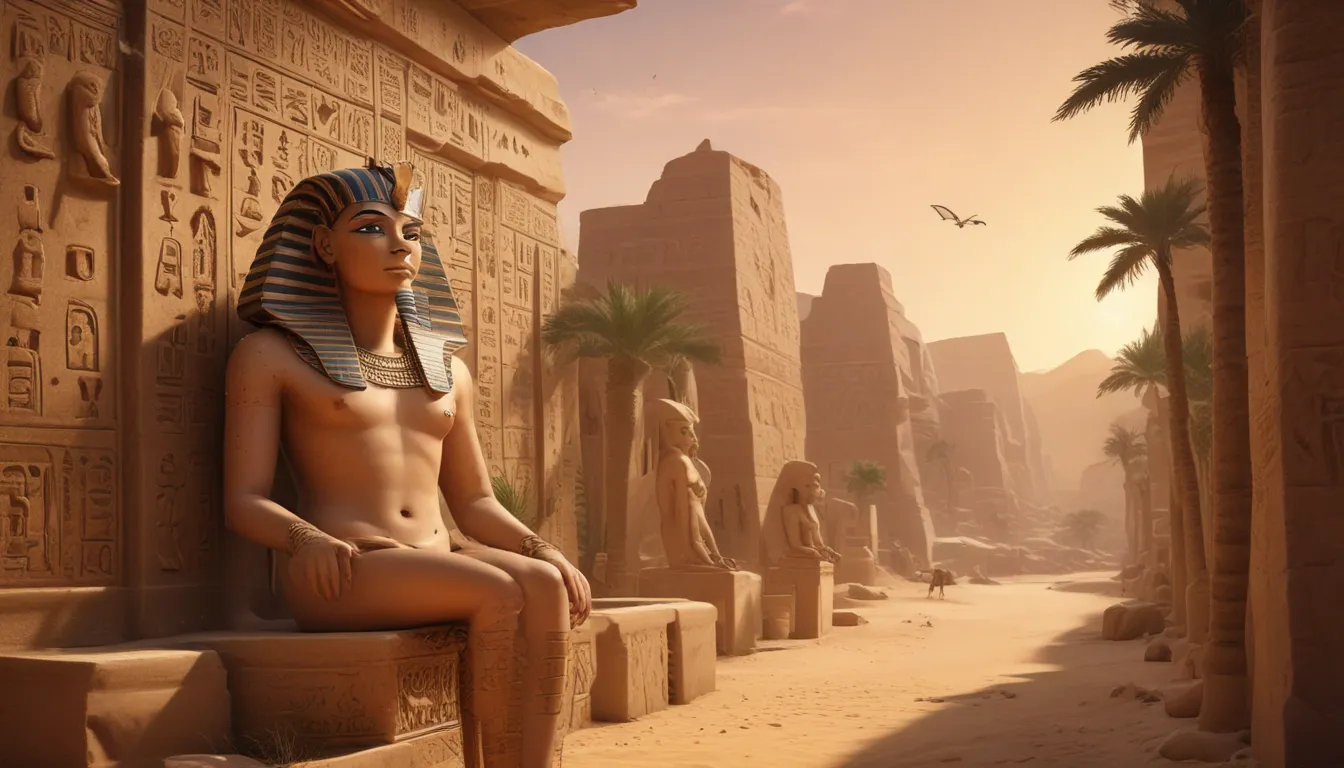The images in our articles may not match the content exactly. They are used to grab your attention, not to show the exact details in the text. The images complement the text but do not replace it.
Have you ever pondered how ancient Egyptians communicated without our modern alphabet? The answer lies within the intricate and fascinating world of hieroglyphics. These ancient symbols served as more than just art; they were a complex system of writing that adorned temple walls, papyrus scrolls, and even tombs. Imagine sending a text with pictures instead of letters – that was the norm in ancient Egypt! From priests to pharaohs, everyone had their stories immortalized in stone through these captivating symbols. Yet, there is much more to hieroglyphics than meets the eye. Some symbols represented sounds, while others held specific meanings, weaving a rich tapestry of ancient knowledge waiting to be unraveled. Let’s embark on a captivating journey through history with words as our guide, as we delve into 26 mind-blowing facts about hieroglyphics. Buckle up as we traverse back in time to explore the ancient scribbles that shaped a civilization!
Key Takeaways:
- Hieroglyphics, the ancient Egyptian writing system, blend images and letters, captivating contemporary audiences with their intricate designs and enduring significance.
- Advances in technology offer new avenues for studying hieroglyphics, enriching our understanding of ancient Egypt’s culture and inspiring various forms of art and literature.
Deciphering the Ancient Script: Understanding Hieroglyphics
Often shrouded in mystery, hieroglyphics served as the formal writing system in ancient Egypt, blending logographic, syllabic, and alphabetic elements to create a truly unique form of communication.
- Originating around 3200 BC, hieroglyphics stand as one of the oldest writing systems in the world.
- The term “hieroglyphic” derives from the Greek words “hieros” meaning sacred and “glyphein” meaning to carve, translating to “sacred carvings.”
Cracking the Code: The Role of the Rosetta Stone
The Rosetta Stone played a pivotal role in unraveling the mysteries of hieroglyphics, providing a key to understanding this ancient language by featuring the same text in hieroglyphic, demotic, and Greek scripts.
- Jean-François Champollion’s decipherment of hieroglyphics in 1822 was made possible by the Rosetta Stone.
- Hieroglyphics weren’t limited to stone carvings but also adorned papyrus, walls, and tombs, showcasing a diverse array of colors and artistic styles.
Delving Deeper: The Structure and Complexity of Hieroglyphics
Hieroglyphics transcend mere visual symbols, representing sounds, concepts, and ideas, with their orientation influencing their meaning.
- With over 700 distinct hieroglyphs, some represent sounds akin to letters, while others convey complex concepts or objects.
- The reading of hieroglyphs can be from left to right, right to left, or top to bottom, depending on the characters’ facing direction.
Beyond the Obvious: Hieroglyphics in Ancient Egyptian Life
Contrary to common misconception, hieroglyphics were not utilized for everyday communication but rather for religious texts, royal edicts, and monumental inscriptions.
- Hieroglyphics found their primary use in religious and official contexts, with daily communication relying on hieratic script.
- The presence of animals and deities in hieroglyphics reflects the profound religious and mythical connections in ancient Egyptian culture.
The Timeless Influence: Hieroglyphics’ Enduring Legacy
Despite the passage of millennia, hieroglyphics continue to captivate imaginations and offer insights into ancient Egyptian culture, shaping contemporary art and literature.
- Interest in hieroglyphics surged after the discovery of Tutankhamun’s tomb in 1922, sparking a global fascination with ancient Egypt.
- Hieroglyphics have inspired diverse art forms and literary works, underscoring their lasting impact on modern culture.
- A subject of continued study and admiration, hieroglyphics symbolize the enduring legacy of Egypt’s civilization.
Unveiling the Mysteries: Hieroglyphics and Technology
Technological advancements have revolutionized the study and interpretation of hieroglyphics, providing new tools and approaches for understanding ancient Egypt’s cultural heritage.
- Digital imaging and 3D modeling enable researchers to analyze hieroglyphics in unprecedented detail, revealing insights into ancient Egyptian society.
- Online databases and apps now offer enthusiasts resources to learn and translate hieroglyphics, democratizing access to this ancient script.
- Artificial intelligence is aiding in deciphering damaged or incomplete hieroglyphic fragments, opening new chapters in Egypt’s history.
Enigmatic Allure: The Unique Appeal of Hieroglyphics
Hieroglyphics retain an aura of mystery and fascination due to their intricate designs and the enigmatic civilization that created them.
- Many hieroglyphic texts remain untranslated, potentially holding groundbreaking insights into ancient Egyptian life, beliefs, and technologies.
- Debates continue regarding the decline of hieroglyphic writing around the 4th century AD, with theories ranging from the spread of Christianity to the simplicity of the Greek alphabet.
- The aesthetic beauty of hieroglyphics makes them popular subjects for tattoos, jewelry, and artwork, blending historical significance with modern fashion trends.
Enlightening Education: Hieroglyphics in Learning
Educators and historians stress the significance of incorporating hieroglyphics into world history curricula, offering students a unique portal into ancient Egyptian culture.
- Learning about hieroglyphics provides students with insights into ancient Egyptian society, religion, and daily life.
- Interactive museum exhibits and educational programs centered on hieroglyphics engage young minds and foster a passion for archaeology and linguistics.
- Virtual reality experiences enable individuals to immerse themselves in ancient Egyptian settings, encountering hieroglyphics in their original context.
Embracing Tomorrow: The Future of Hieroglyphic Studies
As technology and interest in ancient civilizations continue to evolve, the study of hieroglyphics is poised for exciting advancements.
- Ongoing archaeological discoveries in Egypt offer fresh material for hieroglyphic research, promising new understandings of ancient Egyptian society.
- Collaborations among linguists, historians, and computer scientists are driving innovative approaches in translating and interpreting hieroglyphics.
- Public interest in ancient Egypt ensures sustained support for research and conservation efforts, preserving the legacy of hieroglyphics for future generations.
- The integration of hieroglyphic studies into broader academic disciplines highlights their role in understanding human communication and cultural expression.
- Advancements in non-invasive archaeological methods are expected to unveil more about the contexts in which hieroglyphics were used, shedding light on their practical applications and societal significance.
- Increased global awareness of heritage preservation underscores the importance of safeguarding and studying hieroglyphic inscriptions, fostering a deeper appreciation of our shared history and ancient knowledge.
Illuminating Ancient Scripts: Delving into the Legacy of Hieroglyphics
Exploring the realm of hieroglyphics unveils a captivating chapter in human history, showcasing our ancestors’ ingenuity in communication. These symbols, far beyond mere art, served as the cornerstone of ancient Egyptian civilization, documenting history, culture, and beliefs that continue to captivate us today. Understanding hieroglyphics offers a unique perspective on the past, unveiling the complexity and richness of ancient societies. As we’ve journeyed through the 26 best hieroglyphic facts, it becomes evident that these ancient scripts are not mere relics but keys to unlocking the mysteries of a bygone era. They serve as a testament to humanity’s enduring quest to communicate and connect across time, offering endless fascination for historians, linguists, and the intrigued alike. So, the next time you encounter a hieroglyph, remember, you’re peering into the heart of ancient wisdom.
Frequently Asked Questions
Q: What are hieroglyphics exactly?
A: Hieroglyphics, or hieroglyphs, are a system of writing utilized by ancient Egyptians over 5,000 years ago. These pictorial symbols represent objects, sounds, and ideas, creating a complex script inscribed on temple walls, tombs, and scrolls, providing narratives, historical records, and insights into Egyptian culture.
Q: How do we interpret hieroglyphics today?
A: The decipherment of hieroglyphics was made possible by the Rosetta Stone, which featured the same text in hieroglyphic, Demotic script, and Ancient Greek. Through comparative analysis, scholars like Jean-François Champollion unlocked the secrets of hieroglyphics, transforming enigmatic symbols into coherent text accessible through study and dedication.
Q: Were hieroglyphics exclusive to Egypt?
A: Primarily, yes, hieroglyphics were an Egyptian script. However, neighboring cultures influenced by Egypt’s legacy adopted and adapted hieroglyphics. While its core remained within Egypt, its reach extended to adjacent regions, reflecting Egypt’s cultural influence across borders.
Q: Can hieroglyphics convey sounds and concepts?
A: Absolutely! Hieroglyphics possess a versatile nature, representing sounds, objects, and abstract ideas. Some symbols correspond to individual sounds akin to letters, while others encapsulate entire words and concepts. This flexibility allowed ancient scribes to articulate intricate narratives and thoughts through visual artistry.
Q: How long were hieroglyphics in use?
A: Hieroglyphics were utilized for approximately 3,500 years, beginning around 3200 BCE with their gradual decline by the 4th century CE. Their enduring legacy spans millennia, capturing the essence of ancient Egyptian civilization and its communication practices.
Q: Why did hieroglyphics fall out of favor?
A: Multiple factors contributed to the waning use of hieroglyphics. The ascent of Christianity and the influence of the Roman Empire fostered the dominance of Greek and Latin in Egypt, eclipsing hieroglyphics associated with pagan beliefs. Over time, simpler scripts like Coptic gained popularity, leading to the eventual decline of hieroglyphic usage.
Q: Are hieroglyphics relevant in modern times?
A: While no longer used for everyday communication, hieroglyphics persist in art, academia, and cultural expressions. Museums, literature, and media frequently feature hieroglyphics, stimulating curiosity and encouraging further exploration of ancient Egypt. Continued scholarly examination unveils new insights into Egyptian life and beliefs.






